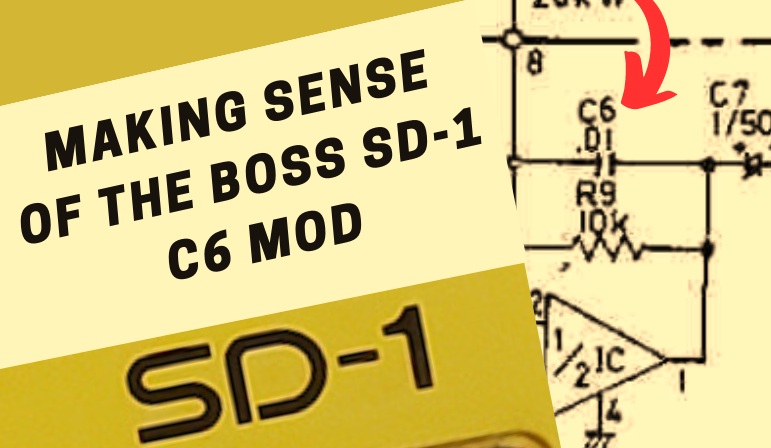
The C6 Mod is by far the most popular modification for the BOSS SD-1. It’s extremely simple, just open the pedal and remove the capacitor labelled C6.
But simple is not always best! If you’re curious about the C6 mod and want to know more, you’re in the right place. In this article, we’ll explore the modification and help you decide if it’s the right choice for your BOSS SD-1 Super Overdrive pedal.
As a member of the Reverb Partner Program and as an Amazon Associate, StompboxElectronics earns from, and is supported by, qualifying purchases.
Disclaimer: Stompbox Electronics and/or the author of this article is/are not responsible for any mishaps that occur as a result of applying this content.
The SD-1’s C6 Capacitor – What Does It Even Do?
Diving into the SD-1 schematic reveals C6 as part of an active low-pass filter. It sits between the output pin (pin 1) and the inverting input (pin 2) of the 4558 op amp, in parallel with a 10k resistor (R9).

It’s a bit much to look at the entire circuit, so let’s extract the important parts:
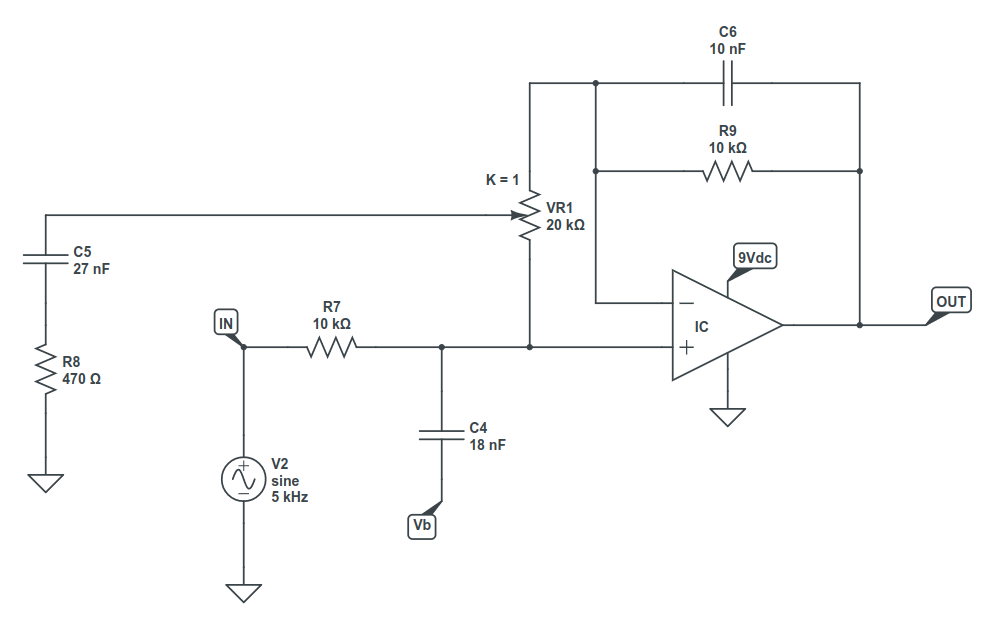
Key Facts:
- R7 and C4 form a passive low pass filter with a cutoff frequency of around 884 Hz.
- Applying the same cutoff frequency equation to C5 and R8 yields about 12581 Hz.
- And doing the same for C6 and R9 gives 1591 Hz.
- The part of the pot labelled “K = 1” indicates the Tone knob at the most counter-clockwise position (all the way up, 100%)
- When the wiper is at the bottom of VR1, the Tone knob is at the most clockwise position (all the way down, 0%)
To get an idea of what C6 is doing, it helps to understand what’s going on with the frequency response (or tonal response) as the Tone Knob rotates.
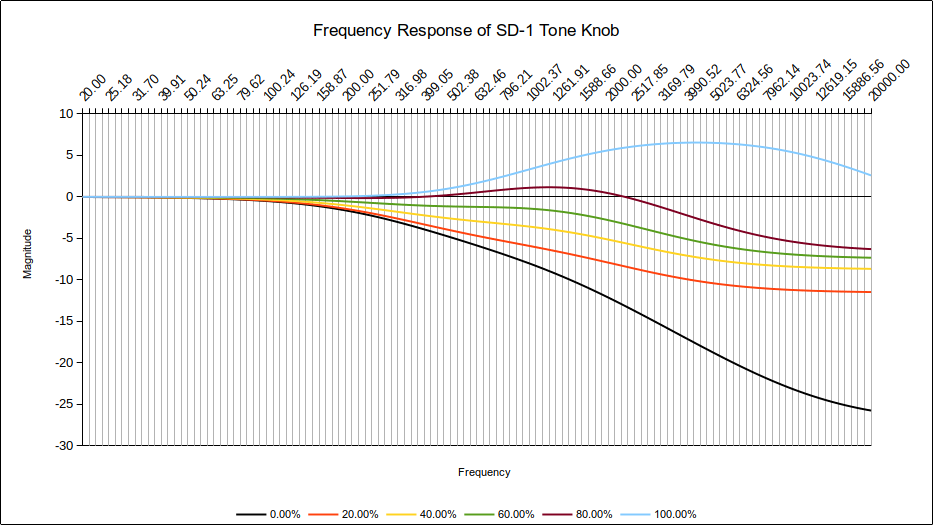
In the chart, the blue line represents the frequency response when the Tone knob is pegged at 100%. The black line marks the 0 position. This chart is telling us that, as the Tone knob rotates, a boost gradually appears in the frequency range between 1591 Hz and 12581 Hz. C6 and R9 are responsible for that 1591 Hz cutoff.
Removing C6 from the BOSS SD-1
Now let’s remove C6 and perform the same experiment. In the schematic below we’ve taken out C6, as done in the popular modification.
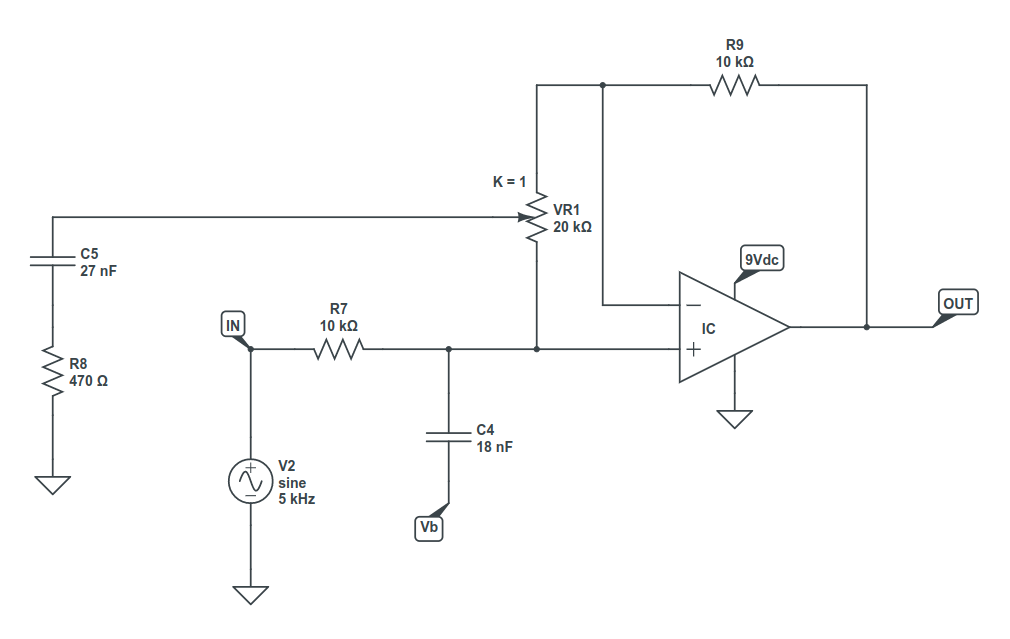
And performing the same frequency scan yields the following graph:
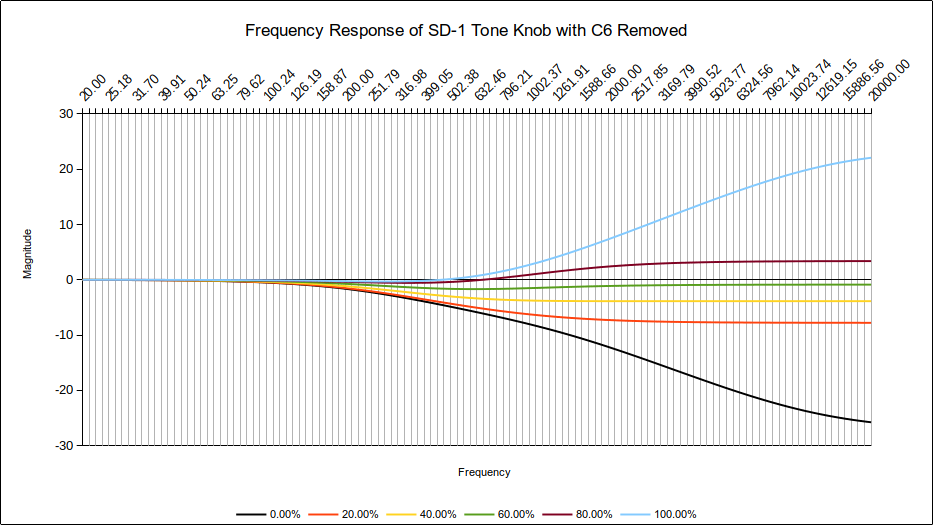
One incredibly obvious result is the lack of that “hump” we saw in the first chart. But that’s when the Tone knob is dimed. Let’s get a better look by comparing each position (20%, 40%, 60%, and 80%) one at a time.
Tone Knob at 20%: Stock vs. C6 Mod
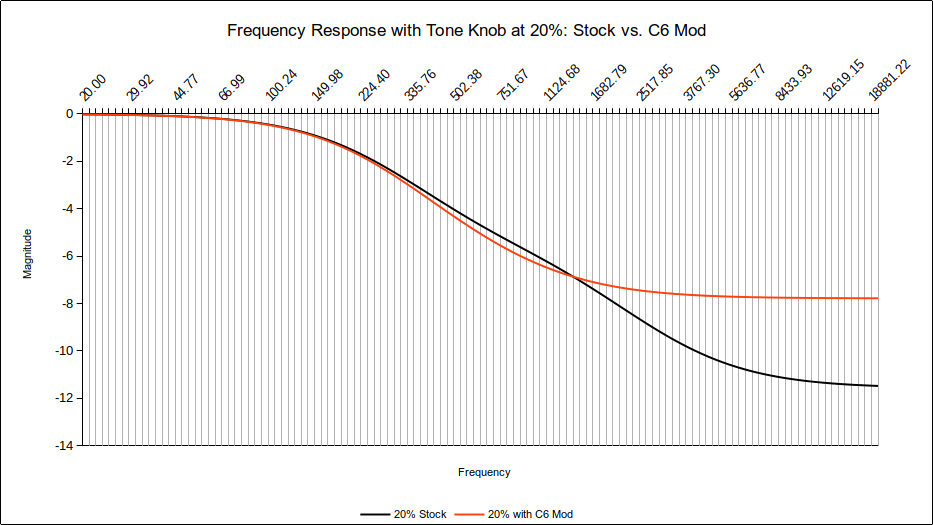
Already at 20% rotation you can see a 4dB gain in highs between stock and C6 modded SD-1! In fact, there are many accounts of players who have performed the C6 mod having to dial back their Tone knobs compared when it was stock. This comparatively rapid increase in highs is most definitely the culprit.
Tone Knob at 40%: Stock vs. C6 Mod
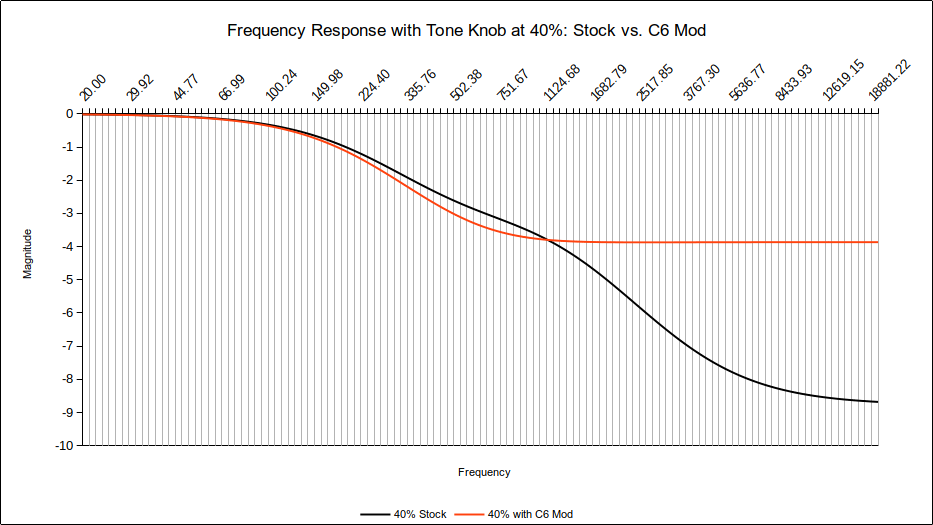
Here’s where thinks get a bit more interesting.
The knob is set just before 12 o’clock. That awkward hump around the 1250 Hz mark is totally gone, as expected since C6 was responsible for it. With the removal of C6, the op amp now starts boosting any frequency in the audio range! You can see by the flat orange line that a shelving filter effect is now more prominent in the modified SD-1.
Tone Knob at 60%: Stock vs. C6 Mod
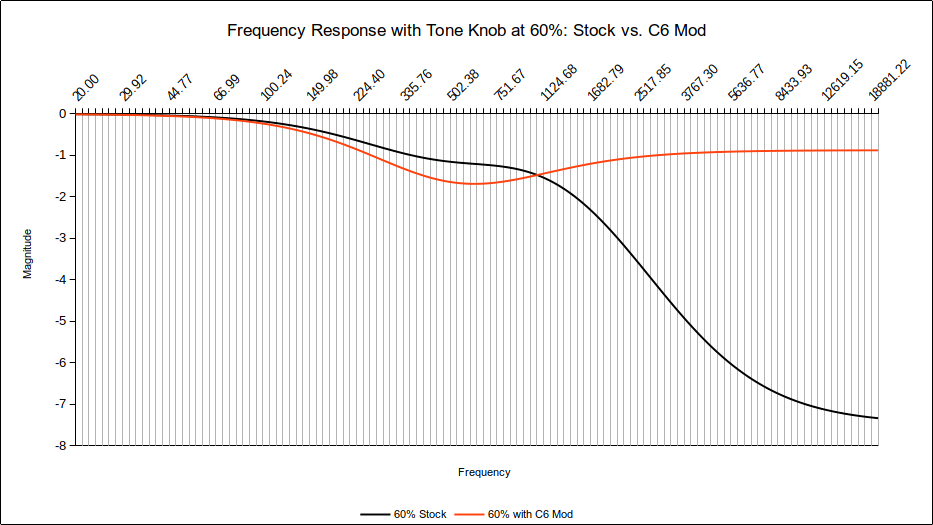
We’re now around the 1 o’clock area. In the modified SD-1 a dip in the low mids occurs while the highs are being let up. Here’s where you’ll start to hear much more “chimey” guitar tones in the upper register.
Tone Knob at 80%: Stock vs. C6 Mod
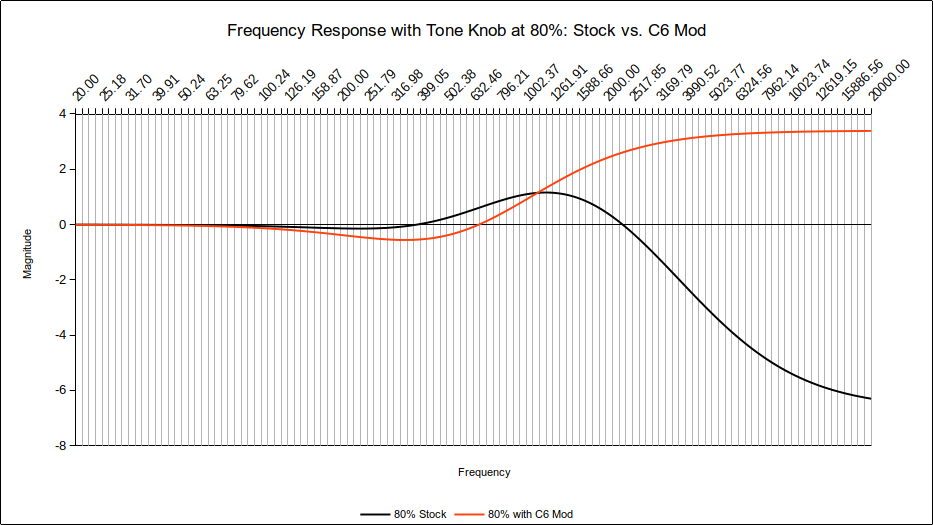
Now this is shrilly!! The knob is set to 80% rotation, about 4 o’clock on the clock. The highs are pumped by over 3dB in the modded SD-1.
In the stock SD-1, that mid hump starts to form around the 500-1800 Hz range. That hump is probably the reason many choose to carry out this mod, in an effort to “open up” the sound. If the goal is to open up the highs, they’ve done a great job!
But can we do better?
Changing the C6 Capacitor
The stock capacitor value for C6 is 0.01uF (10 nF). Removing C6 from the circuit is like taking that capacitance value and decreasing it all the way to zero. If the goal is to “open up” the pedal, then what if we simply tried decreasing the value of C6 until we liked the sound? Suitable replacements types could be Mylar Polyester Film or Metallized Film Box caps, available in kit form on Amazon.
Let’s go back to modeling the stock circuit. We’ll set the Tone knob to 1 o’clock and then see what the tonal response looks like for increasing values of C6.
Below, I’ve sweeped C6’s value from 1nF up to the stock 10nF value, in increments of 1nF.
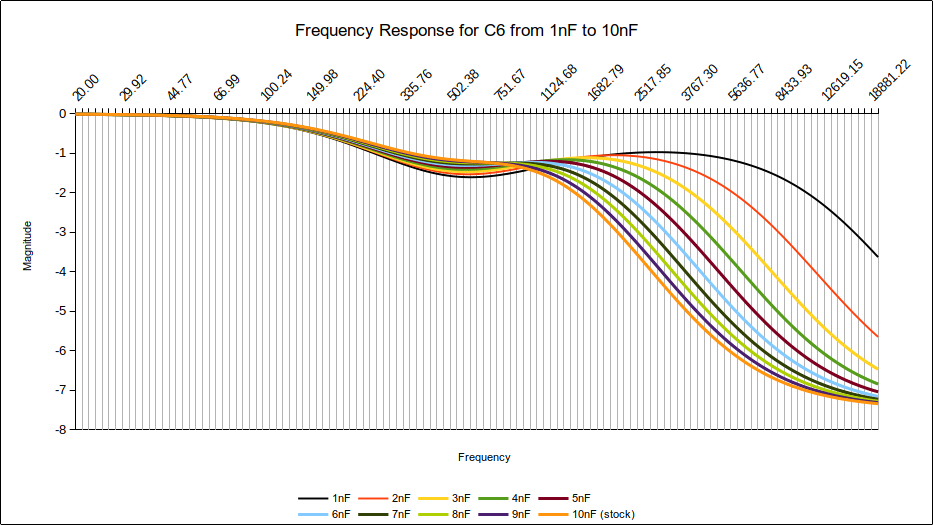
Looks like choosing a cap value between 1nF and the stock value would be more than helpful in opening up the tone!
Meet the Author:

Hi, I’m Dominic. By day, I’m an engineer. By night, I repair and modify guitar effects! Since 2017, I’ve been independently modifying and repairing guitar effects and audio equipment under Mimmotronics Effects in Western New York. After coming out with a series of guitar effects development boards, I decided the next step is to support that community through content on what I’ve learned through the years. Writing about electronics gives me great joy, particularly because I love seeing what others do with the knowledge they gain about guitar effects and audio circuits. Feel free to reach out using the contact form!
The Tools I Use
As a member of Amazon Associates, Stompbox Electronics earns and is supported by qualifying purchases.













